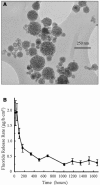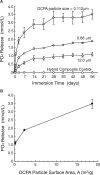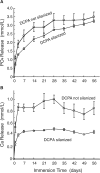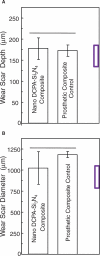Strong nanocomposites with Ca, PO(4), and F release for caries inhibition
- PMID: 19948941
- PMCID: PMC3056546
- DOI: 10.1177/0022034509351969
Strong nanocomposites with Ca, PO(4), and F release for caries inhibition
Abstract
This article reviews recent studies on: (1) the synthesis of novel calcium phosphate and calcium fluoride nanoparticles and their incorporation into dental resins to develop nanocomposites; (2) the effects of key microstructural parameters on Ca, PO(4), and F ion release from nanocomposites, including the effects of nanofiller volume fraction, particle size, and silanization; and (3) mechanical properties of nanocomposites, including water-aging effects, flexural strength, fracture toughness, and three-body wear. This article demonstrates that a major advantage of using the new nanoparticles is that high levels of Ca, PO(4), and F release can be achieved at low filler levels in the resin, because of the high surface areas of the nanoparticles. This leaves room in the resin for substantial reinforcement fillers. The combination of releasing nanofillers with stable and strong reinforcing fillers is promising to yield a nanocomposite with both stress-bearing and caries-inhibiting capabilities, a combination not yet available in current materials.
Figures







Similar articles
-
Nanocomposites with Ca and PO4 release: effects of reinforcement, dicalcium phosphate particle size and silanization.Dent Mater. 2007 Dec;23(12):1482-91. doi: 10.1016/j.dental.2007.01.002. Epub 2007 Mar 6. Dent Mater. 2007. PMID: 17339048 Free PMC article.
-
Effect of filler level and particle size on dental caries-inhibiting Ca-PO(4) composite.J Mater Sci Mater Med. 2009 Aug;20(8):1771-9. doi: 10.1007/s10856-009-3740-2. Epub 2009 Apr 14. J Mater Sci Mater Med. 2009. PMID: 19365616 Free PMC article.
-
Novel CaF(2) nanocomposite with high strength and fluoride ion release.J Dent Res. 2010 Jul;89(7):739-45. doi: 10.1177/0022034510364490. Epub 2010 May 3. J Dent Res. 2010. PMID: 20439933 Free PMC article.
-
Update on dental nanocomposites.J Dent Res. 2010 Jun;89(6):549-60. doi: 10.1177/0022034510363765. Epub 2010 Mar 18. J Dent Res. 2010. PMID: 20299523 Review.
-
Review on fluoride-releasing restorative materials--fluoride release and uptake characteristics, antibacterial activity and influence on caries formation.Dent Mater. 2007 Mar;23(3):343-62. doi: 10.1016/j.dental.2006.01.022. Epub 2006 Apr 17. Dent Mater. 2007. PMID: 16616773 Review.
Cited by
-
Synthesis of new antibacterial quaternary ammonium monomer for incorporation into CaP nanocomposite.Dent Mater. 2013 Aug;29(8):859-70. doi: 10.1016/j.dental.2013.05.005. Epub 2013 Jun 14. Dent Mater. 2013. PMID: 23768794 Free PMC article.
-
Bioactive Dental Composites and Bonding Agents Having Remineralizing and Antibacterial Characteristics.Dent Clin North Am. 2017 Oct;61(4):669-687. doi: 10.1016/j.cden.2017.05.002. Dent Clin North Am. 2017. PMID: 28886763 Free PMC article. Review.
-
Do bioactive materials show greater retention rates in restoring permanent teeth than non-bioactive materials? A systematic review and network meta-analysis of randomized controlled trials.Clin Oral Investig. 2023 Dec 28;28(1):44. doi: 10.1007/s00784-023-05414-3. Clin Oral Investig. 2023. PMID: 38153565
-
Effect of dimethylaminohexadecyl methacrylate mass fraction on fracture toughness and antibacterial properties of CaP nanocomposite.J Dent. 2015 Dec;43(12):1539-46. doi: 10.1016/j.jdent.2015.09.004. Epub 2015 Sep 25. J Dent. 2015. PMID: 26404407 Free PMC article.
-
Novel dental adhesive containing antibacterial agents and calcium phosphate nanoparticles.J Biomed Mater Res B Appl Biomater. 2013 May;101(4):620-9. doi: 10.1002/jbm.b.32864. Epub 2012 Dec 20. J Biomed Mater Res B Appl Biomater. 2013. PMID: 23281264 Free PMC article.
References
-
- Anusavice KJ, Zhang NZ, Shen C. (2005). Effect of CaF2 content on rate of fluoride release from filled resins. J Dent Res 84:440-444 - PubMed
-
- Asmussen E, Peutzfeldt A. (2002). Long-term fluoride release from a glass ionomer cement, a compomer, and from experimental resin composites. Acta Odontol Scand 60:93-97 - PubMed
-
- Bayne SC, Thompson JY, Swift EJ, Jr, Stamatiades P, Wilkerson M. (1998). A characterization of first-generation flowable composites. J Am Dent Assoc 129:567-577 - PubMed
-
- Beun S, Glorieux T, Devaux J, Vreven J, Leloup G. (2007). Characterization of nanofilled compared to universal and microfilled composites. Dent Mater 23:51-59 - PubMed
-
- Braga RR, Ballester RY, Ferracane JL. (2005). Factors involved in the development of polymerization shrinkage stress in resin-composites: a systematic review. Dent Mater 21:962-970 - PubMed
Publication types
MeSH terms
Substances
Grants and funding
LinkOut - more resources
Full Text Sources
Other Literature Sources
Medical

